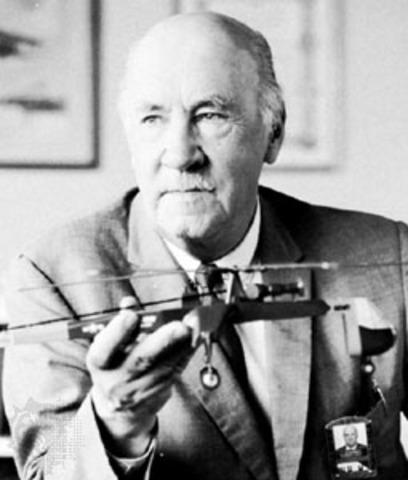
Great Constructors - Part 2
We continue the story of the most famous designers and engineers in the history of the automotive industry. Among other things, you will learn who the rebellious British "garage workers" are, who built the iconic Alpha and Ferrari engines, and who is "Mr Bender". Hybrid".
Polish miracle of technology
Tadeusz Tanski is the father of the first Polish large car.
To the group of outstanding car designers of the first decades car development there is also a Polish engineer Tadeusz Tanski (1892-1941). In 1920, he built in an extremely short time the first Polish armored car Ford FT-B, based on the Ford T chassis. His greatest achievement was CWS T-1 - the first mass domestic car. He designed it in 1922-24.
The world rarity and engineering championship was that the car could be disassembled and assembled with one key (only an additional tool was required to unscrew the candles), and the timing and gearbox consisted of a set of identical gears! It features a built from scratch four-cylinder engine with a volume of 3 liters and a power of 61 hp. with valves in an aluminum head that Tansky designed and built in less than a year. He died during the war, killed by the Germans in the Auschwitz concentration camp.
SWR T-1 in torpedo version
Aston Marek
Since the Polish thread has already appeared, I cannot fail to mention another talented designer from our country who made the greatest career in exile in the UK. In 2019 Aston Martin decided to make 25 replicas Model DB5, the machine that became famous as James Bond's favorite car.
James Bond (Sean Connery) and Aston Martin D
Under their hoods, an engine is running, which was designed by our compatriot in the 60s - Tadeusz Marek (1908-1982). I'm talking about an excellent 6-liter 3,7-cylinder in-line engine with 240 hp; in addition to the DB5, it can also be found in the DBR2, DB4, DB6 and DBS models. The second engine built by Marek for Aston was 8-liter V5,3. The engine best known V8 model advantage, were produced continuously from 1968 to 2000. Marek started his career in the Second Polish Republic as a constructor at PZInż. in Warsaw, where he participated, among other things, in the work on the engine of the legendary Sokół motorcycle. He also competed successfully in rallies and races.
Tadeusz Marek after winning the '39 Polish Rally
garage workers
Apparently, he called them “garages” somewhat maliciously. Enzo Ferrariwho could not come to terms with the fact that some little-known British mechanics in small workshops and for little money build cars that win on race tracks with his fancy and expensive cars. We belong to this group John Cooper, Colin Chapman, Bruce McLaren and another Australian Jack Brabham (1926-2014), world title winner Formula 1 in 1959, 1960 and 1966 he drove cars of his own design with an engine located centrally behind the driver. This arrangement of the power unit was a revolution in motorsport, and it began John Cooper (1923-2000), in preparation for the 1957 season. car Cooper-Climax.
Stirling Moss with Cooper-Climax (No. 14)
Cooper was not a diligent student, but he had a flair for mechanics, so at the age of 15 he worked in his father's workshop, building light rally cars. , Cooper became famous for his amazing tuning popular Mini, the icon of the 60s Mini was the brainchild of another famous British designer Alec Issigonis (1906-1988), who for the first time in such a small, "people's" car placed the engine transversely in front. To this he added a specially designed suspension system with rubber instead of springs, widely spaced wheels and a responsive steering system that made karting fun to drive. It was a great base for Cooper's efforts, who thanks to his modifications (more powerful engine, better brakes and more precise steering) he gave the British midget an athletic vivacity. The car has been incredibly successful in the sport over the years, incl. Three victories in the prestigious Monte Carlo Rally.
Alec Issigonis in front of the Longbridge factory in Austin with the first Mini and the new Morris Mini Minor Deluxe in 1965
Mini Cooper S - winner of the 1965 Monte Carlo Rally
Another (1937-1970) who paid the most attention aerodynamicsinstalling large spoilers and experimenting with downforce. Unfortunately, in 1968 he died during one of these tests, but his company and racing team continued his work and continue to function today.
The third of the British "garage" was the most gifted, Colin Chapman (1928-1982), founder of Lotus, which he founded in 1952. Korobeynik he did not focus on Treadmills. He also built, and their success translated directly into the budget of the racing stable, which entered their cars in all the major races and rallies in the world (in Formula 1 alone, Team Lotus won a total of six individual and seven team championships). ). Chapman went against modern trends, instead of increasing power, he opted for light weight and excellent handling. All his life he followed the principle he formulated: “Increasing your strength makes you faster on a straight line. Bulk subtraction makes you faster everywhere." The result was such innovative cars as the Lotus Seven, which, by the way, under the Caterham brand is still produced almost unchanged. Chapman was responsible not only for their mechanics, but also for the design.
Colin Chapman congratulates driver Jim Clark on winning the 1967 Dutch Grand Prix in a Lotus 49.
How McLaren he had a great knowledge of aerodynamics and tried to apply it in his ultralight cars. Designed by him car lotus 79 became the first model to fully use the so-called. a surface effect that provided tremendous downforce and significantly increased cornering speed. Back in the 60s, Chapman was the first in F1 to use a load-bearing body instead of the frame structure widely used at that time. This solution made its debut in the Elite road model, and then went to the famous car Lotus 25 with 1962 years
Richard Attwood driving the Lotus 25 at the '65 German Grand Prix.
Best F1 Engine
Since we are talking about "garage cars", it's time to write a few sentences about engineers. Cosworth DFVconsidered by many to be the best engine F1 cars in history. An eminent British engineer had the largest stake in this project. Keith Duckworth (1933-2005), and assisted him Mike Costin (born 1929). The two men met while working at Lotus and, after three years of dating, founded their own company, Cosworth, in 1958. Fortunately Colin Chapman he did not take offense at them and in 1965 put them into operation engine assembly for the new F1 car. 3 liters V8 engine featured 90-degree cylinder arrangement, dual four valves per cylinder (-DFV), and new lotus machine, Model 49, was designed by Chapman specifically for Engine Cosworth, which in this system is the supporting part of the chassis, which became possible due to its compactness and rigidity of the block. The maximum power was 400 hp. at 9000 rpm. which allowed to develop a speed of 320 km / h.
Cars with this engine they won 155 of the 262 Formula One races they entered. Drivers with this engine have won F1 12 times, and the designers using it have been the best for ten seasons. Converted to a 1L turbocharged unit, it also won races and championships in the United States. He also led the Mirage and Rondeau teams to win the 2,65 Hours of Le Mans in 24 and 1975 respectively. In Formula 1980, it was used with great success until the mid-3000s.
Cosworth DFV and its designers: Bill Brown, Keith Duckworth, Mike Costin and Ben Rude
There are few engines in automotive history with such a long history of success. Duckworth i Kostina of course, other power units were also produced, incl. excellent motorcycles used in Ford sports and racing cars: Sierra RS Cosworth and Escort RS Cosworth.
See also:
